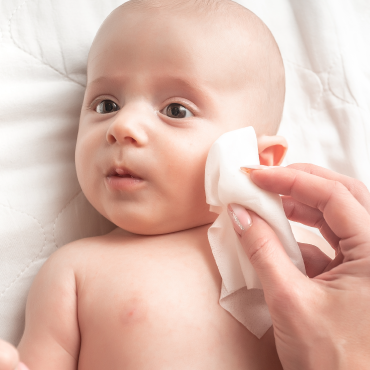At present, Various diseases can causing children getting sick and illnesses. It is therefore recommendable to get to know some illnesses frequently found in children and how to take care of them and prevent them from the diseases.
1.Fever (common cold) Caused mostly by virus infection, fever can occur to children throughout the year.
- When children have fever, they will have symptoms such as nasal congestion with clear mucus, frequent sneezes, dry and sore throat. Many of them will become weak, have headache, dry cough or cough with phlegm. If they have phlegm or mucus over a week, they will become yellow or green. This is caused by complication infection which may lead to sinusitis, inflammation of the middle ear, bronchitis or pneumonia later.
- To protect children from fever, avoid crowded areas and anyone infected with the disease but frequently wash hands and rest sufficiently.
2. Influenza
- Influenza is usually caused by either A or B type viruses. The disease is easily spread as it is airborne from people who sneeze and cough. It can be infected from mucus and saliva as well as from hands of infected children who put them in their mouth or use them to touch their nose.
- Children who have influenza will suffer from high fever, trembling, headache, pains on the body and fatigue. Soon, they will have nasal congestion, running nose, coughing as well as other symptoms like nausea, vomiting and conjunctivitis. Influenza differs from fever (common cold) in that children having the disease will suffer from suddenly high fever, cold, headache, body pains, fatigue and they are highly prone to severe complications such as pneumonia.
- To prevent children from influenza, they should stay away from the patient, wash their hands and have anti-influenza vaccination which can be given to children of 6 months onwards.
3. RSV Bronchitisis a type of virus that causes upper and lower respiratory tract infections. Both children and adults can have the disease. When ones are infected, especially in the lower respiratory tract, 70% of them will have pneumonia and bronchiolitis.
- Children who have the disease, especially the older ones, may have symptoms similar to fever like cough, sneeze and running nose. Some may have hoarseness from laryngitis, bronchitis and cough with phlegm. The symptoms will be recovered within 5 or 7 days. However, the younger children are, the more severe the symptoms will become as children will develop fatigue and difficult breathing. They may have a lot of mucus and breathe with wheezing as if they had bronchitis. Since children cough a lot, they will vomit, be drowsy, can neither have meals nor drink milk and their body may look green. If children are very weak, particularly premature ones or ones having heart or lung diseases and asthma, the symptoms will worsen as children may fail to breathe. In this case, doctors may bring them to ICU and provide them with a respirator.
- Prevention against the disease includes staying away from the patient and washing hands often as no vaccination is found right now.
4. Scarlet fever is caused by a bacteria called group A streptococci which is spread from saliva and mucus by coughing and sneezing.
- Those who have the disease will start having fever/sore throat. Then, they will vomit, have nausea, tremble, have headache and stomachache. Red color rashes will be found in the neck and groin areas before they are seen all over the body. The rashes, when touched, feel like sandpaper. When pressing them, the red color fades. Patients’ tongue may become a thick film as pink as a strawberry. To cure the disease, patients must have an antibiotic like penicillin for 10 consecutive days.
- Children should be prevented from touching the patient. They must wash their hands often as no vaccination is found to cure the disease.
5. Foot and mouth diseaseis caused by various types of virus, mainly enterovirus and coxsackievirus which can spread from touching, saliva, mucus, excrement and germs from a spot on the patient’s skin. The liquids may stay in hands, toys, eating utensils, coughing and sneezing.
- Patients will have high fever, sore throat and ulcers in the mouth/tongue, cheek and palate, which prevent them from eating. Some rashes are also found on the palm/sole or even anal areas. The rashes will become white spots and develop into scars. Some severe complications may occur, such as meningitis, encephalitis or myocarditis. However, the disease is typically not severe and patients may have fever for a couple of days before getting better in 7-10 days after that.
- To prevent the disease, avoid touching the patient, wash hands, eat well-prepared, clean and freshly made food and drink clean water as no vaccination is found.
6. Diarrhea from Norovirus or Rotavirus typically occurs to children who use hands to touch the patient and put them in the mouth.
- Those suffering from the disease will have nausea, vomit, stomachache, headache, fever and defecate in liquid form. In case of too much times of defecation, water and minerals will be released from patients’ body so much that they lose consciousness and even suddenly die. Therefore, patients should drink sufficient water and have very light meals.
- To prevent the disease, children should stay away from the patient, frequently wash hands, have food that is well-prepared and clean and drink clean water. At present, there is only one anti-rotavirus vaccine, the first dose of which can be given to a baby of 2 months but not older than 4 months.
7. Dengue feveris caused by dengue virus which can be categorized into 4 types. It is spread by aedes, a kind of mosquito.
- Those infected with the disease will have high fever for several days along with headache, drowsiness, rare urination, cold, body pains and nausea. Fever will last for 4 or 5 days before it drops and rashes are seen on the body. Some patients may develop complications such as bleeding caused by low blood platelet or dehydration. Unfortunately, no medicines can cure dengue fever right now.
- To prevent the disease, avoid getting bitten by aedes and reduce the number of mosquitoes by getting rid of their breeding sources. A net to prevent mosquitoes from entering into a room should be installed. At present, there is an anti-dengue fever vaccine recommended for those already infected. Children of 9 years old or older can get vaccinated.
8. Chicken poxis caused by a virus and easily infected by touching the patient who sneezes or coughs.
- Initially, patients will have body pains, eat little and some red swellings can be seen on their body, arms, legs and face. Then, the swellings will become acne-like with red color before they turn white and form a scab that leaves a scar when dry. Some children will develop complication caused by bacterial skin infection as they can not help scratching the skin while others, who have low immunity, may develop more severe symptoms like pneumonia, meningitis and encephalitis to death.
- To prevent the disease, children must stay away from the patient, wash their hands and get vaccination which can be provided to children of 1 year old and over.
9. Measlesis a kind of rash fever that has become frequent now. The virus can be found in patients’ nose and throat. It is easily spread from coughing, sneezing and speaking in close distance. As the virus is airborne, it is infected by breathing in patients’ mucus, phlegm and saliva to the body. Otherwise, the virus is inhaled when it is in the air. The number of patients of measles once decreased after the introduction of a vaccine, but are increasing in some countries where people do not want to have vaccination.
- Patients who have measles will suffer from fever, running nose, red eyes, coughing and photosensitivity for a few days before Koplik’s spots are found in their cheek. The symptoms will worsen with high fever, especially on the fourth day. The spots will spread from the cheek to face, hairline, body, arms and legs and stay there for a couple of days. After that, fever will become lower and the spots’ color will turn darker until they are dull red or dark brown for 5-6 days until they disappear. The symptoms last two weeks and sometimes, the skin may be too dry and flaky.
- their hands. Vaccination against measles is recommendable for children of 1 year old and older.
Article written by Dr. Piyarat Lertbannaphong, specialized pediatrician.
Crated At 14/05/2019



















